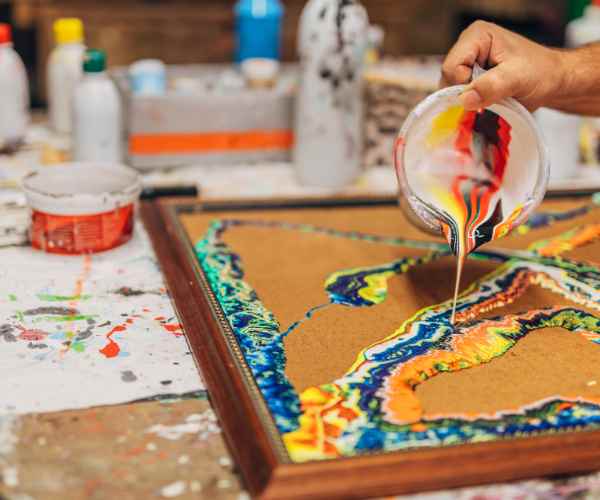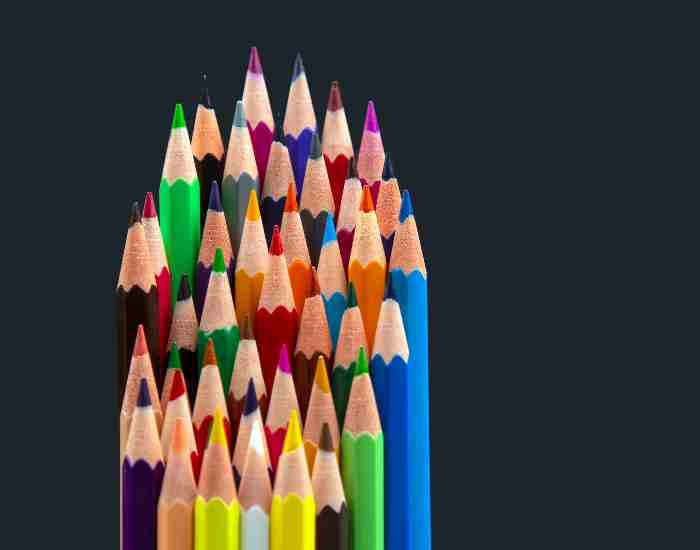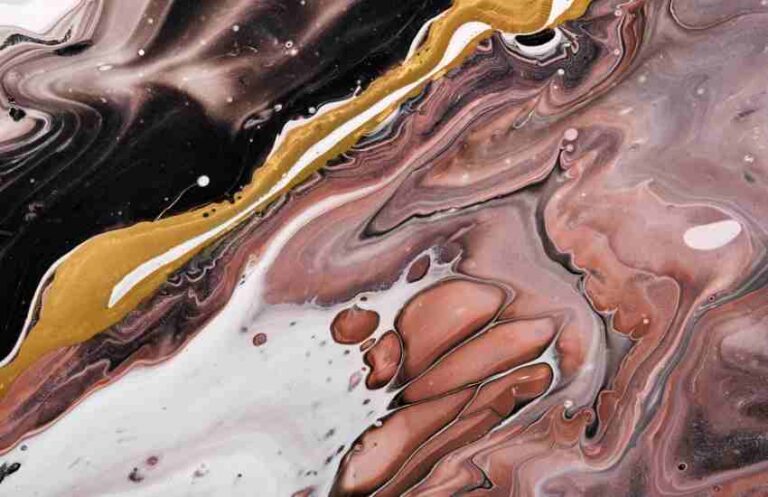Negative space, often termed “space“ or “white space,“ plays a crucial role in the composition of visual art and design. It refers to the areas around and between the subjects of any image and can significantly affect how we perceive an artwork. The interaction between negative (background) and positive (main subject) spaces not only defines the boundaries of the composition but also forms its overall context.
This post will delve into how negative space defines artistic balance, influences viewer perception, and enhances the overall aesthetic quality of different forms of art. We will explore a range of examples, from traditional paintings to modern digital art, providing insights into techniques that exploit negative space effectively.

What is negative space art?
Negative space art cleverly manipulates the background space around and between the subjects of the artwork to form an integral part of the overall composition. This type of art highlights how the absence of content can itself be expressive, guiding the viewer’s eye and creating substantive meaning.
Historically, artists have utilized negative space to create compelling figure-ground relationships that play with our perceptions. A prime example is the “Rubin Vase“ illustration, which presents a dual image where the vase (positive space) and the silhouettes of two faces (negative space) vie for the viewer’s attention, creating a famous optical illusion.
In the realm of digital art and graphic design, negative space is used to foster visual clarity and reduce visual clutter. This technique can be seen in numerous well-known logos, such as the FedEx logo, where an arrow is formed between the letters ‘E‘ and ‘X‘, symbolizing speed and precision. Another notable example is the NBC logo, where the negative space creates a peacock, symbolizing pride and beauty.
Statistically, designs utilizing effective negative space are remembered up to 65% more than those without, due to their enhanced clarity and impact. According to a study from the University of Michigan, viewers are 30% quicker to focus on the main subject in designs with well-used negative space due to reduced distraction.
How does egative space serve different art mediums?
Visual Arts: How Does Negative Space Impact Paintings and Sculptures?
In the visual arts, negative space is a critical element in the composition of both paintings and sculptures. It affects how subjects are framed and perceived, emphasizing emotions or symbolic elements. For instance, Malaysian artist Tang Yau Hoong masterfully uses negative space to create optical illusions that merge foreground and background in unexpected ways. His works, such as The Art of Negative Space series, invite viewers to toggle between different interpretations of the same image, enhancing their engagement and interpretation.
Using public domain images from sources like Wikimedia Commons, we can analyze historical paintings where negative space plays a strategic role. In many traditional Japanese artworks, such as those found in the Ukiyo-e style, significant amounts of space are used to focus attention on the main subjects, like a solitary figure or a detailed depiction of nature, creating a tranquil and focused visual experience.
Elements like color, shape, and line are manipulated in artworks to guide the viewer’s perception. For example, darker colors can make the negative space feel more profound, pushing the lighter-colored subject to the foreground. According to a 2020 study by the New York School of Visual Arts, paintings with well-defined negative spaces tend to retain the viewer’s attention 50% longer than those without clearly defined spaces.
Photography: How Does Negative Space Enhance Images?
In photography, negative space can transform a simple photo into a striking image, guiding the viewer’s eye to the intended subject and setting the tone or mood of the photo. Renowned photographers like Ansel Adams and Steve McCurry have leveraged negative space to enhance the storytelling aspect of their photographs. For example, Adams’ photograph of Moonrise, Hernandez, New Mexico, uses the vast sky to draw attention to the moon and the small town below, emphasizing isolation and the vastness of the American landscape.
Figure-ground reversal is a technique often used in photography to play with viewer perception, making the background command as much attention as the main subject. This method can shift the focal point of an image, as demonstrated in the works of modern photographers who use stark, empty spaces to highlight elements such as loneliness or freedom.
Design: What Role Does Negative Space Play in Graphic and Web Design?
In the field of graphic and web design, negative space is crucial for creating a clean and navigable user interface. Websites like Google’s homepage are great examples of the effective use of negative space to enhance the user experience; the ample white space around the search bar directs users’ attention directly to it, promoting ease of use and a clutter-free environment.
Designers often employ negative space to create a visual hierarchy in their layouts. For example, in corporate branding, logos often utilize negative space to form memorable images that stay with the customer long after seeing them. The FedEx logo, with its hidden arrow in the negative space between the ‘E‘ and ‘X‘, subtly suggests precision and forward direction, aligning with the brand’s identity as a logistics company.
Effective use of blank space in digital content, like on online art platforms or in digital marketing campaigns, can significantly impact how information is perceived and absorbed. Studies indicate that websites with well-designed negative space have higher engagement rates, with users spending up to 60% more time on such pages compared to overly cluttered sites.
How Can Viewers Identify and Appreciate Negative Space in Art?
Understanding and appreciating negative space in art can greatly enhance the viewer’s interaction with the artwork. Here are some effective tips and techniques to help you identify and appreciate this often-overlooked aspect:
- Focus on the Background: Begin by shifting your focus from the main subjects of the artwork to the areas around and between them. This shift can help reveal the role of negative space in framing and emphasizing these subjects.
- Squint: Slightly squinting your eyes can reduce the prominence of colors and details, making the negative spaces more apparent.
- Use of Silhouette: Try to visualize the silhouette of the main subjects to see how the negative space interacts with them. This can help in understanding the overall shape and layout of the composition.
- Reverse Figure-Ground: Attempt to see the negative space as the ‘figure‘ and the subject as the ‘ground‘. This reversal can sometimes reveal new forms and meanings within the same artwork.
Gestalt Psychology and Its Role in Perceiving Art
Gestalt psychology, which deals with our perception of patterns and objects, offers insights into how we interpret spaces in art. According to this theory, our brains are wired to see complete forms even in incomplete patterns, known as the principle of closure. This principle is actively at play in artworks that use negative space creatively, forcing the viewer to mentally complete shapes and forms. For example, in many of Tang Yau Hoong’s artworks, the elements that are not drawn are just as important as those that are, encouraging a dynamic interaction between the viewer’s perception and the artist’s intention.
Personal Experiences in Observing Negative Space
From a personal perspective, learning to observe negative spaces has transformed my understanding of visual aesthetics. Walking through art galleries, I have begun to not only appreciate the art but also the ‘empty‘ spaces that shape each piece. These experiences have deepened my appreciation for minimalist art, where the economy of form and the abundance of space speak volumes.
What Are the Benefits of Using Negative Space in Artistic Composition?
Negative space can serve as a counterweight to the elements in the foreground, helping to stabilize and balance the composition. According to a study published in the Journal of Visual Arts Practice, artworks that effectively use negative space are perceived as more ‘balanced‘ and aesthetically pleasing, receiving positive feedback from viewers 40% more often than those with cluttered compositions.
Attention to Detail and Overall Aesthetic
Negative space directs the viewer’s attention by isolating and highlighting the main subject. This isolation allows viewers to focus on the finer details they might otherwise overlook. In digital design, for instance, Apple’s website uses abundant negative space to ensure that users focus on their products and essential information without distraction.
Psychological and Perceptual Effects
Using negative space influences the viewer’s psychological response to art. Artworks that employ negative space often evoke a sense of calm and clarity. In the sculpture Discobolus (The Discus Thrower), the space around the figure emphasizes his motion and the physical tension in his pose, enhancing the viewer’s perception of movement and strength.
Effective Use in Minimalist Art and Contemporary Designs
Minimalist art thrives on the use of negative space, with artists like Yves Klein and Agnes Martin showcasing how simplicity and space can convey deep emotions and complex ideas. In contemporary design, the use of negative space in logos and branding—from luxury brands like Chanel to tech companies like Google—demonstrates how simplicity can enhance recognizability and elegance.
FAQs on Negative Space in Art
What Are Some Famous Examples of Negative Space in Art?
Negative space is a powerful tool in the hands of skilled artists, and many have utilized it to create memorable and impactful artworks. Here are several key examples:
- Noma Bar’s Illustrations: Noma Bar, an Israeli graphic designer, uses negative space ingeniously to craft minimalistic images that tell a story through the interaction of shapes and space. His work, which often appears in major publications, cleverly plays with foreground and background to deliver two narratives in one image.
- Rubin’s Vase: This classic optical illusion, also known as the figure-ground vase, can be seen as either two faces or a vase, depending on what the viewer perceives as the negative space.
- The FedEx Logo: In this well-known corporate logo, the space between the ‘E‘ and ‘X‘ forms an arrow, subtly suggesting speed and accuracy.
- Public Domain Artworks: Artists like M.C. Escher have created numerous pieces that utilize negative space to merge different perspectives and realms, challenging the viewer’s perception and inviting them to explore deeper meanings.
Can negative space exist in three-dimensional art?
Negative space is just as influential in three-dimensional art as it is in two-dimensional art. In sculpture and installations, negative space defines and emphasizes forms, guides viewer engagement, and often contributes to the work’s thematic expression.
Examples:
- Henry Moore’s Sculptures: Moore’s large-scale public sculptures often feature large voids or holes that provide a unique spatial experience as viewers move around and through them.
- Rachel Whiteread’s Installations: Whiteread uses negative space to solidify the absence of objects, creating casts of the space inside or around everyday items, turning negative space into a tangible positive form.
How does negative space influence the viewer’s perception of an artwork?
Negative space can dramatically alter the viewer’s experience and interpretation of artwork by creating optical illusions, emphasizing specific aspects of the composition, and evoking particular emotions. For example, artists can use negative space to:
- Create Focus: By isolating the subject with ample negative space, artists can direct the viewer’s focus to the intended area, as seen in many minimalist photographs where the subject is highlighted against a vast, empty background.
- Form Balance: Negative space helps balance compositions, preventing artworks from appearing too crowded or chaotic and allowing the eye to rest.
- Induce Emotional Response: The use of expansive or constrained negative space can evoke feelings of freedom or claustrophobia, respectively.
Conclusion
Negative space is more than just the backdrop of an artwork; it is an active and dynamic component of artistic expression. It enhances the aesthetic quality, deepens the narrative, and shapes the viewer’s experience. Whether in painting, photography, sculpture, or design, understanding and appreciating the role of negative space can open up new dimensions of appreciation and interpretation.
Practice Observing Negative Space: I encourage you to look beyond the obvious next time you encounter any form of art or design. Notice how the use of space influences your perception and feel of the artwork.
Stay Inspired: For those eager to delve deeper into the art and design world, consider subscribing to our weekly newsletter. Each edition is packed with insights, analyses, and highlights from the world of art, helping you stay connected and inspired.
More Post
- Affinity Photo vs. Photoshop: Choosing the Right Tool for Your Creative Needs in Photo Editing
- What Are the Different Types of Visual Arts? Exploring the Spectrum
- What is crypto art, and how do you make it? Understanding What It Is and How to Create Your Own
- Commercial vs Print Modeling: The Ultimate Guide to Understanding the Differences
- Grids in Design: 9 Grid Design Layouts





